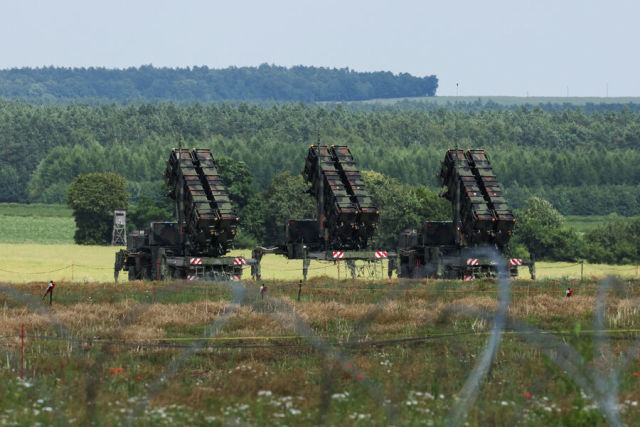Colonel Khodarenok: Zelensky wants to turn the eastern border into the Maginot line
French Defense Minister Sebastian Lecorny, commenting on the so-called "victory plan" of Ukrainian President Vladimir Zelensky, suggested that it was time for the West to think about providing Kiev with non-nuclear deterrence. What they can represent and whether Kiev's allies are really ready to spend their strength and money on this project, the military columnist of the Newspaper figured out.En" Mikhail Khodarenok.
The term "non-nuclear strategic deterrence package" was first used during the presentation by Vladimir Zelensky in the Verkhovna Rada of his plan to end the conflict. There have never been similar statements from the military and political leadership of other countries before. So in this area, the President of Ukraine is certainly a pioneer.
As usual, having thrown another slogan into the information space, Zelensky did not explain to the city and the world what he specifically understands by the term he invented. In other words, the President of Ukraine did not describe anything by points and deadlines and did not say a word about what forces and means would be involved to implement this plan.
According to Zelensky, this "containment package" should put Moscow in a dilemma - either switch to diplomacy or lose its military machine. This item of the "victory plan" also has a secret application - the president of Ukraine handed it over to the leadership of the United States, Britain, Germany, Italy, and France. It cannot be excluded that Zelensky outlined a number of details in this application. Let's say right away that the full implementation of this point of the "victory plan" is possible only after the end of the armed conflict.
Commenting on Zelensky's proposal, French Defense Minister Sebastian Lecorny suggested that the West address the issue of deploying "non-nuclear deterrence forces" in Ukraine.
"This "victory plan" is the beginning of a political path. It is necessary to ask the question of what will happen after. Imagine a ceasefire or a peace treaty - you will understand that the issue of deploying non-nuclear deterrence forces on the territory of Ukraine in order to be able to repel a new threat from Russia is obviously an issue that already needs to be addressed," he said.
Total reboot of the APU
Let's try to imagine what a "non-nuclear strategic containment package" of the President of Ukraine might look like. It is quite possible that the main tasks that Zelensky plans to solve with the help of his "package" in the future armed conflict with Russia look like this: repelling missile and airstrikes; defeating aviation and nuclear missile groups; suppressing the invasion of enemy Ground forces; fighting to hold defensive lines in operational and strategic depth.
Now let's consider what the President of Ukraine will need to make such plans a reality. After all, we are talking about nothing more and nothing less than building a strategic defense of the country. That is, Zelensky needs to place the AFU groups in an appropriate operational and strategic structure, create a system of defensive lines and operational engineering barriers, deploy air defense and missile defense systems in the theater of military operations.
By and large, in order to solve these tasks, it is necessary to "reinstall" the Armed Forces of Ukraine almost in full. They should include formations of operational and tactical aviation (equipped with modern multifunctional fighters), missile brigades of operational and tactical medium-range ballistic missiles, units and formations of long-range ground-based cruise missiles. At the same time, the number of carriers should go to many hundreds and thousands, and the radius of their combat use should extend at least to the Ural Mountains.
Money for Zelensky's "package"
As you know, dreaming is not harmful. Now only Western politicians and the military need to figure out what it will cost for the budget of the NATO member countries to implement Zelensky's plans.
And if, during the conduct of hostilities, the costs of Ukraine can somehow be explained to the taxpayers of the EU and NATO, then in order to implement Zelensky's "package" they will have to work hard to explain to Europeans and Americans how such large-scale costs of recreating Ukraine's military power are related to their vital interests. Kiev, as you know, is bankrupt economically, financially and militarily, and can formulate only one thing in front of the West - "give it!".
Now, as for the political and military elite of Ukraine, which is developing such "packages", then one can say the traditional about its representatives (Zelensky did not develop such plans alone) - they did not understand anything and did not learn anything.
The political class of Ukraine today needs to think not so much about anti-tank hedgehogs and gouges (rows of wooden pillars or granite blocks dug into the ground, used as a barrier; also called "dragon's teeth") on its eastern border, as about normalizing relations with its great northeastern neighbor. Because it was Kiev's unfriendly and openly insulting policy towards Moscow that in many ways brought Ukraine to its current state. And in the future, it can also bring Kiev to a complete knockout if the vectors of Ukrainian policy remain the same.
The opinion of the author may not coincide with the position of the editorial board.
Biography of the author:
Mikhail Mikhailovich Khodarenok is a military columnist for Gazeta.Ru", retired colonel.
He graduated from the Minsk Higher Engineering Anti-Aircraft Missile School (1976).
Military Air Defense Command Academy (1986).
Commander of the S-75 anti-aircraft missile division (1980-1983).
Deputy commander of the anti-aircraft missile regiment (1986-1988).
Senior Officer of the General Staff of the Air Defense Forces (1988-1992).
Officer of the Main Operational Directorate of the General Staff (1992-2000).
Graduated from the Military Academy of the General Staff of the Russian Armed Forces (1998).
Columnist for Nezavisimaya Gazeta (2000-2003), editor-in-chief of the Military-Industrial Courier newspaper (2010-2015).
Mikhail Khodarenok


